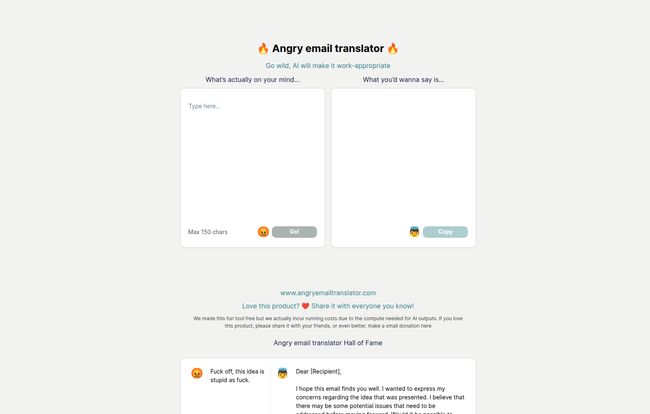We’ve all been there. Staring at the screen, fingers hovering over the keyboard, blood pressure slowly climbing. A coworker has just taken credit for your idea. A client has made an impossible, last-minute demand. Your boss, Carl, has scheduled another pointless meeting that could have been an email. The rage-filled draft you’ve just typed would make a sailor blush. You want to hit send. Oh, you really want to hit send.
But you don't. Because you're a professional. You have bills to pay and a reputation to maintain. So you delete the whole thing, take a deep breath, and type out something vaguely passive-aggressive that still lets a little bit of the frustration seep through.
What if there was a better way? What if you could have a digital buffer, a kind of AI diplomat that takes your raw, unfiltered fury and translates it into the polished, polite, corporate-speak that keeps the professional world spinning? Well, I stumbled across a little gem called the Angry Email Translator, and folks, it’s a game-changer.
So, What Exactly is the Angry Email Translator?
It’s pretty much what it says on the tin. The Angry Email Translator is a dead-simple, free-to-use AI tool that takes your angry, frustrated, or just plain snarky text and rewrites it into a professionally acceptable email. The website’s tagline says it all:
Go wild, AI will make it work-appropriate.
And they're not kidding.
The interface couldn't be cleaner. On one side, you have a box titled, “What’s actually on your mind…” and on the other, “What you’d wanna say is…”. You type your fiery diatribe on the left, hit 'Go', and like magic, a calm, cool, and collected version appears on the right. It’s the digital equivalent of counting to ten and having a PR agent whisper in your ear.

Visit Angry Email Translator
My First Spin: Taking the Translator for a Test Drive
Naturally, I had to put it through its paces. The site has this hilarious “Hall of Fame” that showcases some real zingers and their polite translations, which gave me a pretty good idea of what it could do.
For instance, the raw input: "Carl, last meeting was a fucking waste of time. I'm not F'in doing this again. Email me, or fuck off."
Becomes the beautifully corporate: "Dear Carl, I hope this email finds you well. I wanted to follow up on our last meeting and express my concerns regarding it... In the future, I would appreciate it if we could communicate via email to ensure that our time is used efficiently..."
Seeing this, I had to try my own. I imagined a scenario where a supplier completely missed a deadline. My inner monologue was something like:
Where the hell is the report you promised me two days ago?! This is completely screwing up my timeline.
I typed that into the translator. The result?
Hi [Name], I'm writing to follow up on the report that was scheduled for delivery on [Date]. I haven't received it yet and was wondering if you could provide an update on its status. Our project timeline is dependent on this information, so any update you can provide would be greatly appreciated.
It’s… perfect. It's polite but firm. It communicates the urgency without the accusation. It's the email I should write, but often don't have the patience for when I'm genuinely annoyed. The tool didn't just remove the anger; it added the necessary professional framing. I was impressed.
The Good, The Bad, and The Professionally-Worded
Like any tool, it’s not without its quirks. After playing with it for a while, I've got some thoughts on where it shines and where it might stumble a little.
The Things I Genuinely Love
First off, the price. It's free. In a world of endless SaaS subscriptions, a genuinely useful tool that costs nothing is a breath of fresh air. They have a donation link, which I think is a great model for a utility like this.
It’s also incredibly easy to use. There's no sign-up, no tutorial, no learning curve. You land on the page and you can use it immediately. It’s a fantastic “emotional circuit breaker.” The simple act of typing your angry thoughts into the box is cathartic in itself. Then, seeing the polished version gives you a ready-made path forward that doesn’t involve burning bridges.
I also think it’s a brilliant tool for non-native English speakers or junior team members who might be struggling with professional tone. It can be a great learning aid to see how a direct, sometimes harsh, sentiment can be rephrased constructively.
Where It Gets a Bit... Vague
Now for the other side of the coin. The main drawback is that sometimes, the translation can sand down the edges a little too much. If you have a very specific, nuanced point to make within your frustration, the AI might generalize it into a blander corporate statement. It might not capture the exact original intent. You should always treat the output as a first draft—a fantastic one, but one that might need a small tweak to perfectly fit your situation.
My other minor gripe is the lack of information about the AI model itself. Is it a fine-tuned version of a major LLM like GPT? Is it a proprietary model? We don't know. For a free tool, this isn't a dealbreaker, but it does leave a little question mark hanging in the air, especially regarding data privacy. I'd probably avoid putting any truly sensitive company information in there just to be safe.
Who Is This Digital Diplomat Actually For?
Honestly? Almost everyone who works in an office or communicates digitally for a living. But I can see it being particularly clutch for a few groups:
- The Passionate & Hot-Headed: If your passion sometimes boils over into your emails, this is your new best friend.
- The Non-Confrontational: For those who hate conflict, this tool helps you address issues clearly and directly without feeling like you're being “mean.”
- The Over-Thinkers: Spend 30 minutes agonizing over a single sentence? Let the AI give you a starting point and save yourself the headache.
- Managers: Need to give difficult feedback? This can help you frame it constructively and professionally, taking the personal sting out of it.
The Bigger Picture on AI and How We Talk at Work
Tools like the Angry Email Translator aren't just novelties; they represent a shift in how we approach workplace communication. We're all drowning in emails and Slack messages, and the potential for misinterpretation is huge. Poor communication is incredibly costly. A study cited by SHRM (the Society for Human Resource Management) revealed that poor communication costs companies with 100 employees an average of $420,000 per year. Yikes.
AI assistants can act as a crucial buffer. They provide a quick gut check on our tone and clarity. Of course, there's a fine line to walk. We don't want to completely outsource our voices and all sound like corporate robots. The goal isn't to be fake, but to be effective. And sometimes, effective means taking your raw, honest frustration and wrapping it in a package that the other person can actually receive without getting defensive. This tool helps you do just that.
Frequently Asked Questions
Is the Angry Email Translator really free to use?
Yes, as of my review, the tool is completely free. They do have a link for donations if you find the tool valuable and want to support its creators, but there's no required payment or subscription.
How does it handle my data? Is it private?
This is a great question. The site doesn't have a detailed privacy policy, which is common for small, free projects like this. As a general rule, I would advise against inputting highly confidential or sensitive personal/company information. Use it for general workplace scenarios, but maybe not for drafting a letter about top-secret project details.
Is this just the same as using ChatGPT?
While you could probably get a similar result by giving ChatGPT a very specific prompt, this tool is much faster and more specialized for this one single task. There's no login, no complex prompt engineering. You just type and go. It's designed for speed and convenience when you're in the heat of the moment.
Does the AI always get it right?
Not always perfectly. In my experience, it does a fantastic job about 90% of the time. However, it can sometimes produce a result that's a bit too generic or misses a subtle nuance of your original point. Always read over the suggestion and think of it as a strong starting draft, not a final, unchangeable text.
Can I use it for more than just emails?
Absolutely! While it's called an "email translator," you can use it for any short-form text. It's great for tricky Slack messages, comments on shared documents, or even professional text messages. Any situation where tone is critical, this tool can help.
My Final Word: A Must-Have in Your Digital Toolkit
Is the Angry Email Translator going to revolutionize the industry? Probably not. But is it a brilliantly simple, incredibly useful, and kinda fun tool that could genuinely save you from a major workplace faux pas? Absolutely. It’s a safety net for your career.
Think of it as a friend who grabs your arm right before you send a text you’ll regret. It gives you a moment to pause, and then offers a better, more strategic way to say what you need to say. For the low, low price of absolutely nothing, it’s one of the best little utilities I’ve found this year. Go bookmark it. Your future self—and probably your boss, Carl—will thank you.
Reference and Sources
- The Tool Itself: Angry Email Translator
- On Communication Costs: The Cost of Poor Communications - Society for Human Resource Management (SHRM)
- On Email Etiquette: A Guide to Professional Email Etiquette - Harvard Business Review



